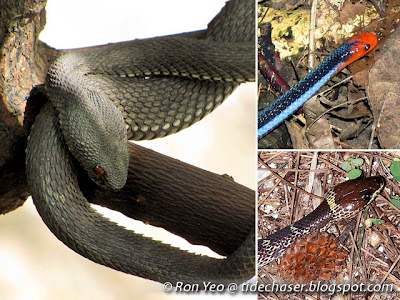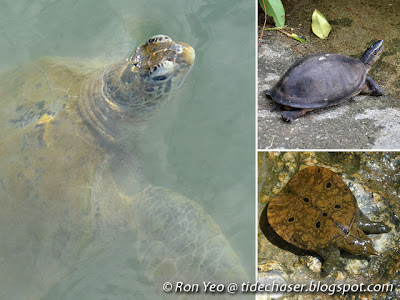Reptiles (phylum Chordata, subphylum Vertebrata, superclass Tetrapoda, class Reptilia) are vertebrates (animals with a backbone and a hollow tube of nervous tissue called a spinal cord) characterised by their limited physiological means to maintain the body temperature within a narrow range, and their ability to produce water-tight eggs.
Being unable to maintain the body temperature within a narrow range (or being ectothermic) means that they are more reliant on external heat sources. Meanwhile, the water-tight eggs are better protected from the external environment compared to the eggs produced by amphibians and fishes. Other vertebrates which produce water-tight eggs include the birds and the mammals (though only a few species of extant mammals still produce eggs), and they are usually referred to as "amniotes". They are descended from four-limbed ancestors (hence the superclass Tetrepoda which means "four legs"). The birds and mammals are endothermic though, being able to generate body heat and maintain the body temperature within a narrow range. Also, birds and mammals are covered in feathers and hair/fur respectively, while reptiles are mostly covered in scales.
Most reptiles lay eggs (oviparous), though some species may bear live young (viviparous), or bear live young from eggs brood within the body (ovoviviparous).
Here are some of the reptiles that I have seen in Singapore:
A) ORDER SQUAMATA
The order Squamata comprises the lizards and snakes. They can be distinguished from other reptiles by their relatively slender bodies that are covered by scales; extremely movable upper jaws which allows them to swallow relatively large prey; and the males possessing penises that that in pairs (each called a hemipenis).

Lizards (suborder Lacertilia) are reptiles with a slender body covered by scales, four limbs (hence the superclass Tetrepoda which means "four legs") and a tail. Some species, however, may have very reduced limbs or no limbs at all. The legless species may resemble snakes, but unlike the latter, most lizards have eyelids and external ears.

Snakes (suborder Serpentes) are legless reptiles with a long and somewhat cylindrical body. They resemble legless lizards, but lack the eyelids and external ears that most lizards possess.
B) ORDER CROCODILIA

Crocodilians (order Crocodilia) are semi-aquatic reptiles with a long snout, short limbs with webbed feet, and a muscular, laterally compressed tail. They have large and powerful jaws with conical teeth, allowing them to effectively hunt for fish and other animals. Their body is covered in tough and leathery plate-like scales. They have a special eyelid-like membrane which covers the eye when they are underwater.
C) ORDER TESTUDINES

Turtles (order Testudines or Chelonii) are air-breathing reptiles with four limbs, a tail, and an external shell modified from their ribs. The shell comprises a shield-like carapace on their back and a flat bony plate (plastron) protecting their bellies. When disturbed, they can either completely or partially withdraw the head, limbs and tail into the shell for protection.
References
Being unable to maintain the body temperature within a narrow range (or being ectothermic) means that they are more reliant on external heat sources. Meanwhile, the water-tight eggs are better protected from the external environment compared to the eggs produced by amphibians and fishes. Other vertebrates which produce water-tight eggs include the birds and the mammals (though only a few species of extant mammals still produce eggs), and they are usually referred to as "amniotes". They are descended from four-limbed ancestors (hence the superclass Tetrepoda which means "four legs"). The birds and mammals are endothermic though, being able to generate body heat and maintain the body temperature within a narrow range. Also, birds and mammals are covered in feathers and hair/fur respectively, while reptiles are mostly covered in scales.
Most reptiles lay eggs (oviparous), though some species may bear live young (viviparous), or bear live young from eggs brood within the body (ovoviviparous).
Here are some of the reptiles that I have seen in Singapore:
A) ORDER SQUAMATA
The order Squamata comprises the lizards and snakes. They can be distinguished from other reptiles by their relatively slender bodies that are covered by scales; extremely movable upper jaws which allows them to swallow relatively large prey; and the males possessing penises that that in pairs (each called a hemipenis).

Lizards (suborder Lacertilia) are reptiles with a slender body covered by scales, four limbs (hence the superclass Tetrepoda which means "four legs") and a tail. Some species, however, may have very reduced limbs or no limbs at all. The legless species may resemble snakes, but unlike the latter, most lizards have eyelids and external ears.

Snakes (suborder Serpentes) are legless reptiles with a long and somewhat cylindrical body. They resemble legless lizards, but lack the eyelids and external ears that most lizards possess.
B) ORDER CROCODILIA

Crocodilians (order Crocodilia) are semi-aquatic reptiles with a long snout, short limbs with webbed feet, and a muscular, laterally compressed tail. They have large and powerful jaws with conical teeth, allowing them to effectively hunt for fish and other animals. Their body is covered in tough and leathery plate-like scales. They have a special eyelid-like membrane which covers the eye when they are underwater.
C) ORDER TESTUDINES

Turtles (order Testudines or Chelonii) are air-breathing reptiles with four limbs, a tail, and an external shell modified from their ribs. The shell comprises a shield-like carapace on their back and a flat bony plate (plastron) protecting their bellies. When disturbed, they can either completely or partially withdraw the head, limbs and tail into the shell for protection.
References
- Baker, N. 2013. Ecology Asia. Retrieved Feb 12, 2013, from http://www.ecologyasia.com.
- Baker, N. & K. Lim, (Vertebrate Study Group, Nature Society Singapore). 2008. Wild Animals Of Singapore. Draco Publishing and Distribution Pte. Ltd. 180 pp.
- Das, I. 2010. A Field Guide to the Reptiles of South-east Asia. New Holland Publishers (UK) Ltd. 376 pp.
- Lim, K.P. & L. K. Lim. 1992. A Guide to the Amphibians & Reptiles of Singapore. Singapore Science Centre. 160 pp.

No comments:
Post a Comment